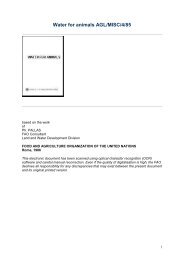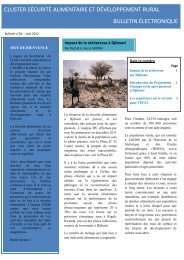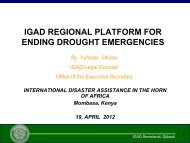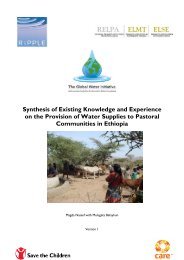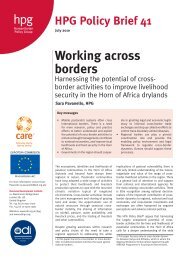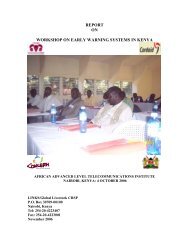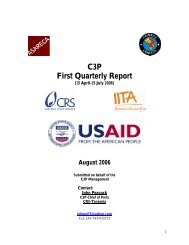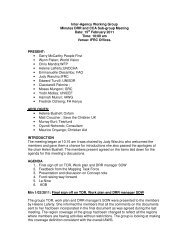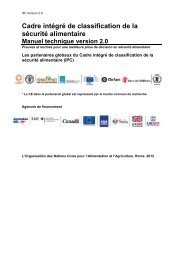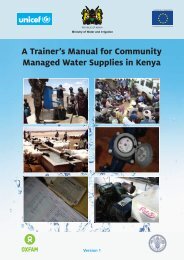Training report Community strategy.pdf - Disaster risk reduction
Training report Community strategy.pdf - Disaster risk reduction
Training report Community strategy.pdf - Disaster risk reduction
- No tags were found...
Create successful ePaper yourself
Turn your PDF publications into a flip-book with our unique Google optimized e-Paper software.
TRAINING ON COMMUNITY STRATEGY FOR COMMUNITY HEALTH WORKERSTANA RIVER – MCH PROJECTFigure 1: CS training14TH – 23TH APRIL 2011VENUE: MADOGO SECONDARY SCHOOLReport prepared by:1. GATIE VICTOR - TRAINER&2. DANIEL K. LAGAT CO-TRAINER1
Introduction<strong>Training</strong> objectivesThe training was guided by the following objectives:1. To enable the community health workers understand the concept of community <strong>strategy</strong> andthe interlink between community <strong>strategy</strong> and their roles as CHWs2. To enable the CHW understand and thence apply the knowledge, skills and attitudes incommunity –based health care systems.3. To demonstrate knowledge and skills in community based health care and referral system inrelation to maternal and child health (MCH) with a view to strengthen the link between thecommunity and health facility/care services.4. Enhance coordination and networking thus improve efficiency and timeliness during emergencyobstetric and other MCH case referral and or management at all levels5. The CHWs to understand community based-health information/data collection and <strong>report</strong>ing1. <strong>Training</strong> Implementation30 community health workers drawn from all locations in the project area were trained on community<strong>strategy</strong>. The workshop was implemented using participatory methodology, including lectures andsmall group discussions, plenary sessions and use of illustrated presentations.The training focused on the following areas:• History of community <strong>strategy</strong>• Objectives of community <strong>strategy</strong>• The eight pillars of primary health care• The roles of community health workers and their position in the community <strong>strategy</strong>• <strong>Community</strong> based health information system (CHIS)• Overview of SRH in emergencies including MISPParticular sections from Kenya National Health strategic plan 2011 – 2016 – community <strong>strategy</strong> wasused as the training guideline in accordance with the timetable, attached as Appendix 1.2.<strong>Training</strong> Evaluation2.1 Pre- and post - test assessmentAt the beginning of the training, participants undertook a pre-test and at the end they undertook a posttest.The pre and post test questionnaire had 7 multiple choice questions and 13 semi-structuredquestion in totality 20 question.A total of 30 participants did the pre-test and the whole group again did the post-training test. In thepretest the lowest score was 28% while in the post-test it was 54% showing an average improvement of26%. In the pretest the highest score was 75% by two of the participants who were active CHWstrained previously by APHIA II, while in the post-test the highest score was 95 % with 3 of theparticipants attaining these score.4.2 End of training evaluationAt the end of the training, the participants also completed an open-ended questionnaire. Thisquestionnaire sought to capture participants’ opinions of the training as well as theirrecommendations for such training courses for their peers in the future.2
The participants generally felt that all the sessions were useful, and were taught in an excellentway. Some of the statements used to describe their perception on the training methodologyinclude: ‘it was the best’, ‘allowed participation’, ‘precise and to the point’, ‘very nice andenjoyable’, ‘superb’, ‘thorough’, ‘lively’, ‘elaborate’, ‘organized’, ‘encouraging’, ‘so interestingand excellent’, among others.Although all the participants indicated that they enjoyedthe training, especially the discussions on maternalhealth (the correlation between FGM, unskilled deliveryand obstetric complications such as vesico-vaginal fistulawhich the group had case scenarios in their respectivelocations; and now understood the problems), the detailson importance of immunization, <strong>risk</strong>s of worm infestation,the need for early detection and treatment of feverespecially for under-fives and expectant mothers and therole of CHWs in linking communities to health facilities and advocacy against FGM, 60% feltthat the duration of the training was short, while the rest felt that it was just right. In theircomments, many indicated that the training should be broken into phases; each at least 10days to allow for a more and thorough discussion of the topics especially on Malariaprevention, HIV prevention & ART treatment, MDR –TB, Family planning, nutrition, CLTS andother sanitation and hygiene promotion methodologies among others and to also allowinclusion of other topics of interest to the group.5.0 Conclusions• The training is of utmost importance since it came at the time the Ministry of Public Healthand Sanitation (MoPHS) is rolling out community <strong>strategy</strong>• The training is very intensive and it would be appropriate to have refresher trainingsannually3
APPENDIX 1: List of ParticipantsFULL NAMES(as would appear on official documents)Sex ID NO> Location1. Abdulahi Ibrahim M 24905874 Sala2. Hawa Rachu M 25048696 Madogo3. Hadija Mohamed F 24933420 Madogo4. Mohamed Mahat M 6893749 Saka5. Ismail Dabasa M 11889901 Saka6 Sadia Yusuf M 26833084 madogo7 Hawa Dhado M 11890065 Madogo8 Rawa Mariam Abdulahi F 25040996 Madogo9 Abdulahi Godhana M 23479215 Katumba10 Bare Musa H. M 23524444 Katumba11 Ibrahim Yusuf Gababa M 5371803 Bangale12 Kaltuma Hassan Bagaja F 10361488 Mulanjo13 Abdisalan Bagaja M 4405705 Mulanjo14 Abdirahaman Abadela M 4406209 Saka15 Noor Muhamed M 25044143 Madogo16 Musuma Issack M 25045785 Madogo17 Salim A Salim M 22743409 Madogo4
FULL NAMES(as would appear on official documents)Sex ID NO> Location18 Mohamed Hussein F 9768696 Madogo19 Abdi Dus M 22835764 Madogo20 Amina Mohamed F 28285494 Madogo21 Victor Mema M 27130305 Madogo22 Mshmed Fudho M 4405425 Adele23 Damares Musyoka F 20921269 Madogo24 Hassan Bajila M 23663479 Madogo25 Harufa Abdulahi M 25249147 Madogo26 Ahmed Gure M 20507827 Bangali27 Ali Osman M 11890475 Madogo28 Fatuma Maka F 8296874 Bangale29 Amina Mohamed F 28285494 Madogo30 Asha Karani F 4404418 Madogo5
Annex 2: CS training programmeVENUE: ----------------DATE: 14th – 23rd April 2011DAY 8:00 – 10:00 A.M. B10:30 A.M. – 1:00 P.M. L2:00P.M. – 4:30 P.M12Arrival and registrationIntroductionGround rulesPre-test<strong>Training</strong> ObjectivesElements of PHC – Childhealth and nutritionREAKOpening remarks by RMOverview/history of<strong>Community</strong> <strong>strategy</strong>Elements of PHC – MaternalHealth and Family planingUNCHObjectives ofcommunity <strong>strategy</strong>Elements of PHC –Malaria preventionMaternal health – FGM<strong>risk</strong>s3 ANC and skilled delivery4Vaginal fistula real life casestudies/plenaryHome-based anti-natal care Safe motherhood -Postnatal managementof women and infantMalaria during pregnancyHIV/AIDS - PMTCT5 Elements of PHC – watsanand environmental sanitation6<strong>Community</strong> based healthcareElements of PHC – HIV/AIDS and TBGroup work –Roles/functions of CHWsElements of PHC-Nutrition – infantfeeding.<strong>Community</strong> –basedinformation system6
and plennary7Structure of community<strong>strategy</strong>Key activities undercommunity <strong>strategy</strong>Group work8 Family planning Linking communities tohealth facilities – medicalHealth education andpromotionoutreach/treatment ofcommon ailments9 Comunity mobilization Programme implementation programme monitoring& <strong>report</strong>ing10 Groupwork - workplans Plenary – Action plans Post test/evaluationand closure7



